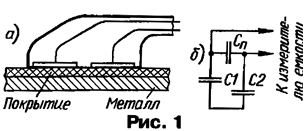In "Radio", 2002, No. 2 in the article by A. Belsky "evaluation of the thickness of the paint coating" has been described a simple device that can detect the areas with uneven the thickness of the protective layer of enamel on the car body. Below we publish description another measuring the thickness of the coating, which has a higher operational qualities.
In the last few years Russia has seen an increased demand for used cars of foreign production. For anybody not a secret that many of these machines have the body, past of refurbishment after various road accidents.
Nearly flawless enamel layer often hides under a badly mauled places, and the fact of body welding of two parts. Sell these machines at prices "unbeaten". Measuring the thickness of coatings can help to identify such defects.
The device described by A. Belsky in "Radio", 2002, № 2, p. 57, can measure the thickness of enamel, applied only on a ferromagnetic base. The sensor is designed for work with flat surfaces - even at low curvature increases sharply measurement error. In addition, to power the device requires network AC voltage of 220 V.

Measuring the thickness of the coating, described below, represents a capacitive a sensor connected to measure small values of capacitance (which can serve as any portable multimeter with a "Sh"). The meter does not depend no metal, which is deposited on a controlled coating (steel, galvanized steel, aluminum alloy, etc.), nor on its thickness.
The sensor comprises two plates of the two series-connected capacitors, a third common electrode which is a metal surface with the studied coating (Fig. 1,a and b). If we assume that the area of the plates strictly identical and the coating evenly over the thickness and dielectric permittivity, the capacitance of the capacitors C1=C2=C, and the capacitance sensor SD = 0.5 s + SP, where SP is the parasitic capacitance between the working electrodes and conductors, connecting the sensor with a capacitance meter.
It is easy to see that, first, the resolution of the sensor is greater than the less parasitic capacitance With respect to C, and, secondly, the capacity of the sensor and the coating thickness are inversely related.
The capacity gauge (I use the device MASTECH M890G) powered of the battery. The sensor does not require power.
Sensor design is not very critical. The device of one of his variants depicted in Fig. 2. As the standard shell used the plug, which removed the contact pins (holder pins are retained) and a flat file is aligned to the working edge.

To edge glue "Moment" attach disk with a diameter of 37 mm, cut from fiberglass thickness of 1.5...2 mm in the Pre-drive drill two the holes for the conclusions of the plates. Made of soft sheet foam rubber thickness 3...4 mm with smooth surfaces cut out a disk of the same diameter and cut in it is the same holes. The rubber disc is glued on a glass fibre laminate, so the holes line up.
The plates are cut from copper or brass foil with a thickness of 0.05 to 0.1 mm with... the seam allowance along the outer contour. The plates opposite the holes, soldered on output by 300 mm long wire MGTF or MGSS section 0,07...0.25 mm2. Conclusion in the soldering should be perpendicular to the surface. Conclusions passed through the holes and the same adhesive bonded plates to the rubber disc as shown in the drawing. The protruding excess foil is cut with scissors, level the edges and smooth out burrs from the working surface of fine-grained sandpaper.
To ensure minimum capacitance of the connecting cable, it is better to make your own. For that, each output of the sensor is put on cut polyethylene tube inner insulation cable television. If the hole in the tube is so small that one could pass him in the findings is not possible, their need to replace segments of winding wire diameter of 0.1 to 0.12 mm....Ends cable definitely fixed in the sensor housing and the block connector.
The block was cut out of foil fiberglass with a thickness of 1 mm, the Foil must to remove, leaving her alone on the contact pins.
When implemented carefully gauge its full capacity does not exceed 10 pF. For comparison: measured capacity in determining coating thickness of about 0.05 mm equal to about 100 pF.
Now only have to make a calibration table in the same order as it described in the above-mentioned article by A. Belsky. As a "calibre" use the leaves paper known thickness. Despite the fact that the calibration dependence non-linear, in practice it is not so important, since the main purpose of the device - search areas of uneven coating thickness.
Briefly about the product. Before measurement of the investigated surface must to remove dust and dried. The sensor is tightly pressed to the surface where, having a minimum curvature and achieve maximum readings. Repeat measurements at several characteristic points. If the object of the research is a car, it is advisable to rent the same table readings with a new car of this model in the showroom.
In conclusion, many seem more convenient to work with analog the capacitance meter with a micro-ammeter output and battery powered. Description such devices can be found in the magazine "Radio".
Author: I. Chekhov, Shchelkovo, Moscow region.






